A Installation Screens for Oracle Data Integrator
This appendix contains images and descriptions for all of the Oracle Data Integrator installation and configuration screens.
The following topics are covered:
-
Section A.1, "Flowchart of the Oracle Data Integrator Installation Screens"
-
Section A.2, "Descriptions of the Oracle Data Integrator Installation Screens"
A.1 Flowchart of the Oracle Data Integrator Installation Screens
Figure A-1 shows the screens you will see during the Oracle Data Integrator installation based on the options you choose during the installation process.
Each screen is described in detail in Section A.2, "Descriptions of the Oracle Data Integrator Installation Screens".
Figure A-1 Flowchart of the ODI Installation Screens
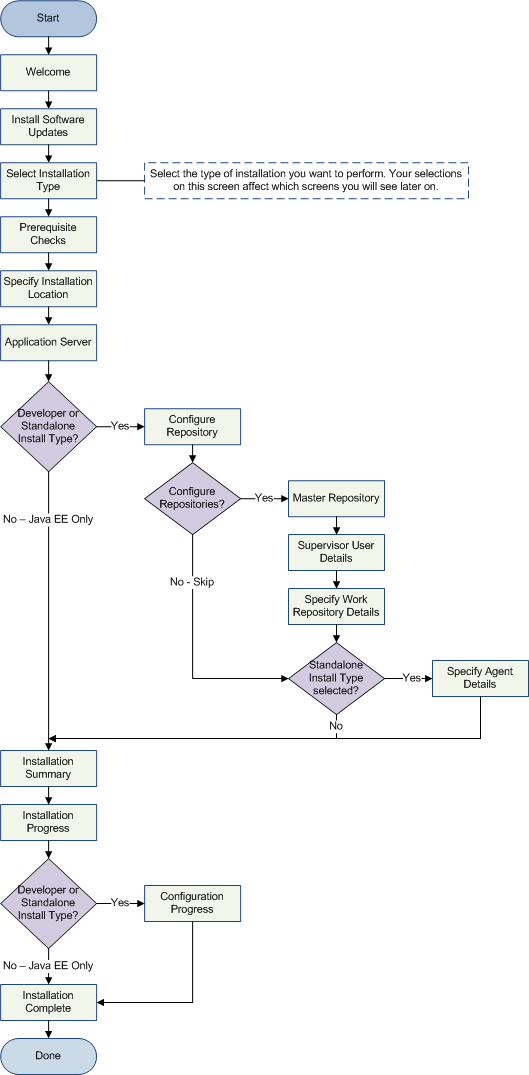
Description of "Figure A-1 Flowchart of the ODI Installation Screens"
A.2 Descriptions of the Oracle Data Integrator Installation Screens
The following topics are covered:
A.2.1 Welcome
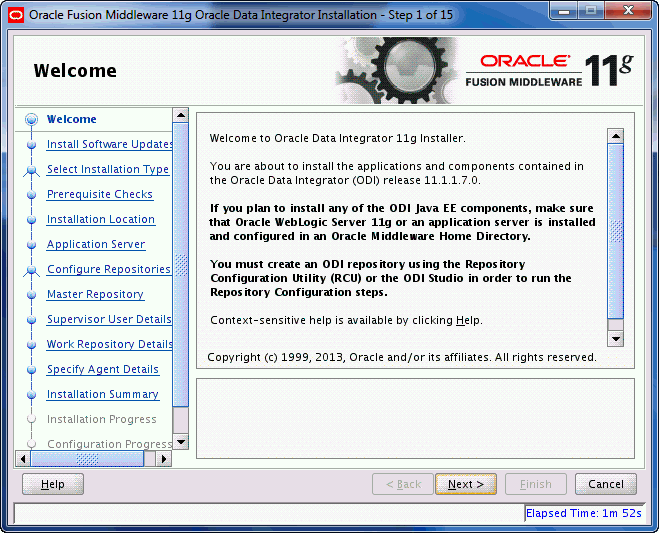
Description of the illustration oui_welcome.gif
This page introduces you to the Oracle Fusion Middleware installer and provides two important pieces of information:
-
A navigation pane on the left that summarizes the tasks the installer will help you complete. Each item in the navigation pane represents a specific installer screen that will prompt you for information required to install the software.
-
Information about any prerequisites you might need to perform before continuing with the installation.
Review the information on this screen carefully to be sure you have performed all the necessary prerequisites.
If you are not sure about any of the prerequisite tasks, refer to the Oracle Fusion Middleware Installation Planning Guide or to Section 2.1, "Verifying Your System and Network Environment".
A.2.2 Install Software Updates
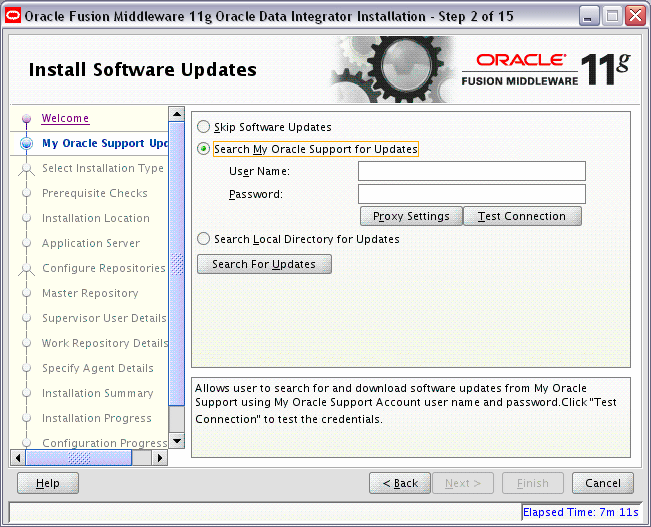
Description of the illustration oui_installsoftwareupdates.gif
Use this screen to select how you want to receive software updates.
The following table describes the options on this screen.
| Field | Description |
|---|---|
|
Skip Software Updates |
Select this option to skip this screen. The installer will not check for updates that might be applicable to the current product installation. |
|
Search My Oracle Support for Updates |
If you have a My Oracle Support account, then select this option to have the installer automatically search My Oracle Support for software updates that apply to the software products are about to install. Enter your My Oracle Support account name and password, and then click Search For Updates. The installer automatically downloads applicable software updates from My Oracle Support. Before you search for update, you can test your login credentials and the connection to My Oracle Support by clicking Test Connection. Click Proxy Settings to configure a proxy server if one is required. |
|
Search Local Directory for Updates |
Select this option if you already downloaded the latest software updates and you want the installer to search a local directory for updates applicable to the products you are about to install. |
A.2.3 Select Installation Type
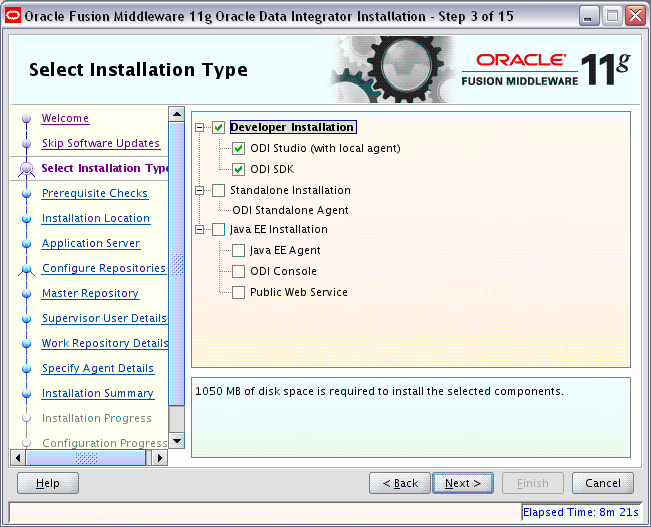
Description of the illustration oui_selectinstallationtype.gif
Use this screen to select the type of installation you want to perform.
The following table describes the fields on this screen:
| Field | Description |
|---|---|
|
Developer Installation |
This installation type includes the ODI Studio (with a local agent) and the Oracle Data Integrator Software Development Kit (SDK). |
|
Standalone Installation |
This installation type includes an Oracle Data Integrator standalone agent. |
|
Java EE Installation |
This installation type includes the Java EE agent, Oracle Data Integrator Console, and Public Web Services. |
A.2.4 Prerequisite Checks

Description of the illustration oui_prereqchecks.gif
This screen analyzes the host computer to ensure that specific operating system prerequisites have been met.
If any of the prerequisite checks fail, then a short error message appears in the bottom portion of the screen. Fix the error and click Retry to try again. If you want to ignore the error or warning messages and continue with the installation, click Continue.
Click Abort to stop prerequisite checking for all components.
More About System Requirements and Prerequisites
Note that before performing any installation you should read the system requirements and certification documentation to ensure that your environment meets the minimum installation requirements for the products you are installing. Both of these documents are available on Oracle Technology Network (OTN).
The Oracle Fusion Middleware System Requirements and Specifications document covers information such as hardware and software requirements, minimum disk space and memory requirements, and required system libraries, packages, or patches.
The Oracle Fusion Middleware certification document for this release can be found on the Oracle Fusion Middleware Supported System Configurations page. This document covers supported installation types, platforms, operating systems, databases, JDKs, and third-party products.
A.2.5 Specify Installation Location
Below is the Specify Installation Location screen if you selected Java EE Installation on the Select Installation Type screen:
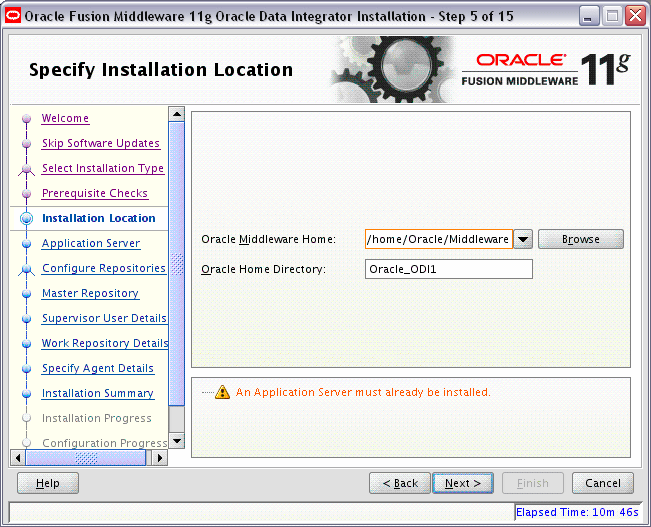
Description of the illustration oui_installloc_javaee.gif
The following table describes the fields on this screen:
| Field | Description |
|---|---|
|
Oracle Middleware Home |
Specify the absolute path to your existing Oracle Middleware Home directory; this is the directory that was created when you installed Oracle WebLogic Server. If you do not know the full path to your Middleware Home, you can click Browse to select an existing directory in your system. |
|
Oracle Home Directory |
Specify a directory inside the Oracle Middleware Home. This Oracle Home Directory is the root directory where the ODI products will be installed. This is also known as the ODI_HOME directory. If you specify a directory that already exists, it must be either:
NOTE: If you specify a new directory, it will be created inside the Oracle Middleware Home. |
Below is the Specify Installation Location screen if you did not select Java EE Installation on the Select Installation Type screen:
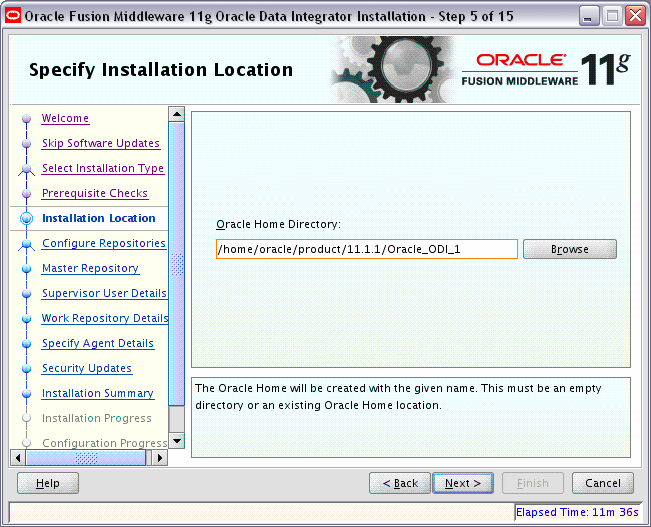
Description of the illustration oui_installloc_sa.gif
In the Oracle Home Directory field, specify the absolute path for the Oracle home location.
A.2.6 Application Server
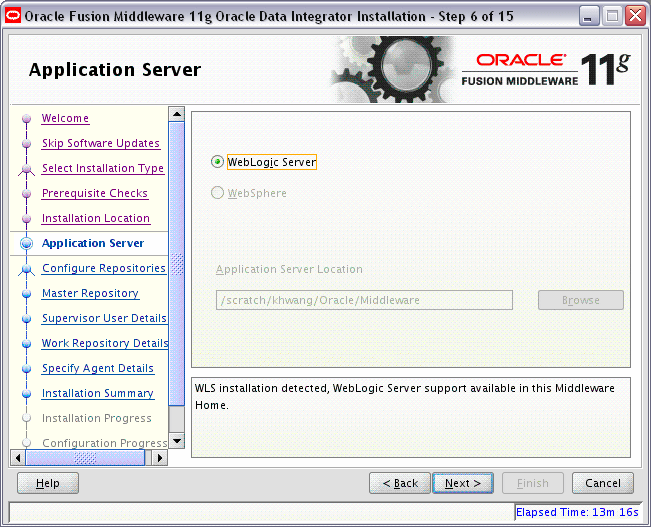
Description of the illustration oui_applicationserver.gif
Use this screen to select the application server you want to use with your ODI components.
| Field | Description |
|---|---|
|
WebLogic Server |
This option is selected by default if the installer detects a Middleware home with Oracle WebLogic Server installed. If no WebLogic Server is detected in the Middleware home, you have the option to select either WebLogic Server or WebSphere as your application server. |
|
WebSphere |
Select this option if you installed an IBM WebSphere application server. This field is inactive when an Oracle WebLogic Server is installed in the Middleware home. |
|
Application Server Location |
Provide the location of your IBM WebSphere application server, if applicable. This field is inactive when an Oracle WebLogic Server is installed in the Middleware home. |
A.2.7 Repository Configuration
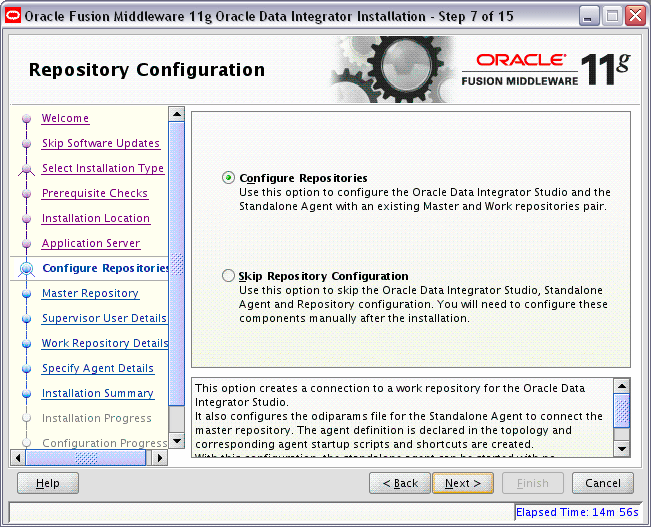
| Field | Description |
|---|---|
|
Configure Repositories |
This option creates a connection to a work repository for the Oracle Data Integrator Studio. It also configures the odiparams file for the Standalone Agent to connect the master repository. The agent definition is declared in the topology and corresponding agent startup scripts and shortcuts are created. With this configuration, the standalone agent can be started with no additional configuration. Select this option if you have existing 11g Master and Work Repositories. |
|
Skip Repository Configuration |
Select this option to continue with the Oracle Data Integrator installation without configuring the repositories. Once installed, you can use the Oracle Data Integrator Studio JDev Gallery to create or configure the repositories. NOTE: Select Skip Repository Configuration if:
For a list of supported databases, see |
A.2.8 Master Repository
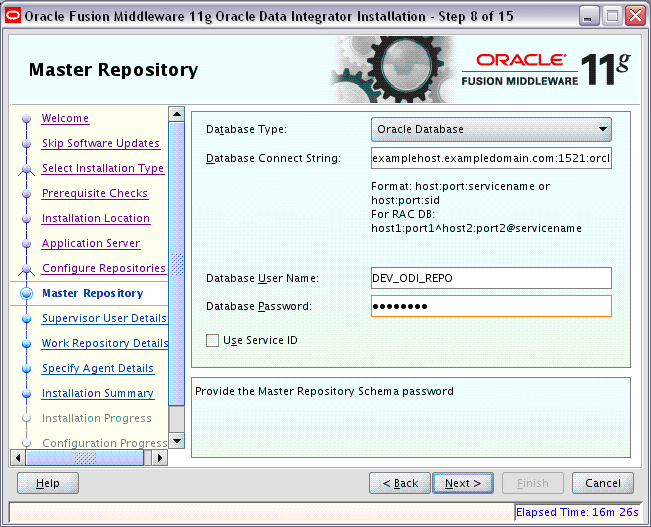
Description of the illustration oui_master_rep.gif
The following table describes the fields on this screen:
| Field | Description |
|---|---|
|
Database Type |
Select the database type that hosts the Oracle Data Integrator Master Repository. |
|
Database Connect String |
Enter the connect string for the database that contains the 11g ODI schemas. Oracle Database Use the following connect string for a single host instance: host:port:SID_or_servicename For example: odiHost:1521:odiDB Use the following connect string for an Oracle RAC instance: host1:port1^host2:port2@servicename For example: odiHost1:1521^odiHost2:1521@odiDB Microsoft SQL Server Database Use the following connect string: serverName:portNumber:instanceName:databaseName For example: odiHost:1443:exampleInstance:exampleDatabase IBM DB2 Database hostname:port:servicename For example: odiHost:1443:exampleServiceName MySQL Database host:port;DatabaseName=name For example: odiHost:1443;DatabaseName=odiDB NOTE: If your database is not supported by the Oracle Universal Installer, see Appendix D, "Manual Installation and Configuration Steps". |
|
Database User Name |
Provide the Master Repository schema user name ( |
|
Database Password |
Provide the Master Repository schema password. |
|
Use Service ID |
Select Use Service ID only if the Master Repository schema resides on an Oracle database and you want to use the Service ID instead of the Service Name for your Oracle database. |
A.2.9 Supervisor User Details

Description of the illustration oui_super_details.gif
The following table describes the fields on this screen:
| Field | Description |
|---|---|
|
ODI Username |
Displays the ODI username with Supervisor privileges. This field cannot be edited. Note that the user name is |
|
ODI Password |
Provide the Supervisor user's password. |
A.2.10 Specify Work Repository Details
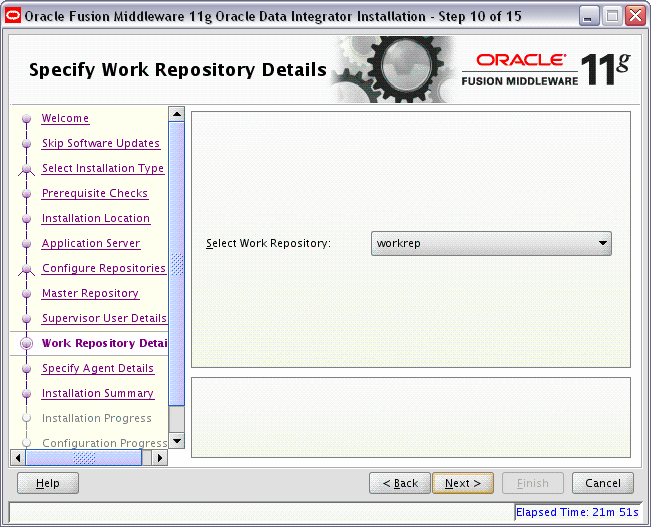
Description of the illustration oui_work_rep_details.gif
Use this screen to select the Oracle Data Integrator Work Repository from the drop-down list.
A.2.11 Specify Agent Details
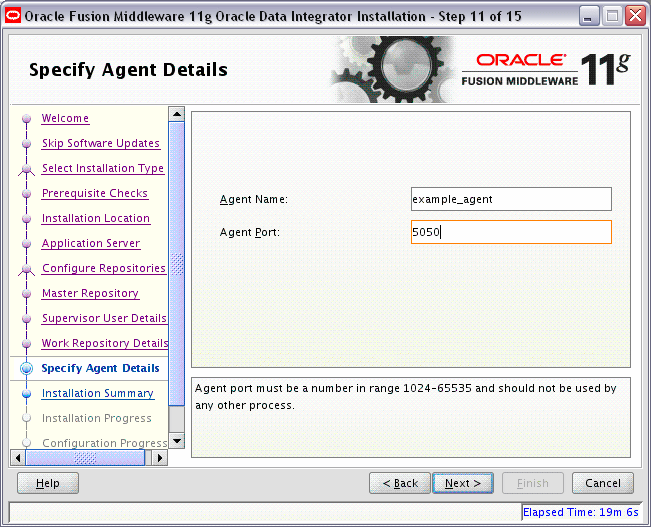
Description of the illustration oui_agent_details.gif
The following table describes the fields on this screen:
| Field | Description |
|---|---|
|
Agent Name |
Provide a name for the standalone or local agent. |
|
Agent Port |
Provide a port number between 1024 and 65535 that is not currently being used by any other Oracle home. This port defaults to 20910. |
A.2.12 Installation Summary
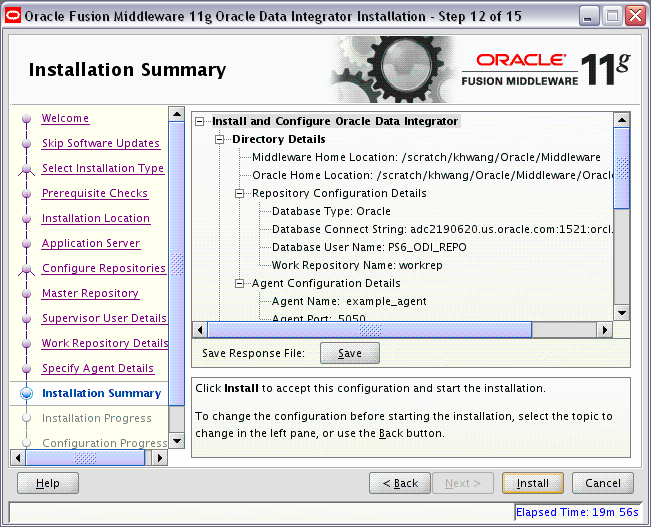
Review the information on this screen, and click Install to begin the installation. The operations summarized on this page will be performed when you click Install.
If you want to make any changes to the configuration before starting the installation, use the navigation pane and select the topic you want to edit.
If you want to save this configuration to a text file, click Save. This file can be used later if you choose to perform the same installation from the command line. See Appendix C, "Silent Installation and Deinstallation" for more information.
A.2.13 Installation Progress
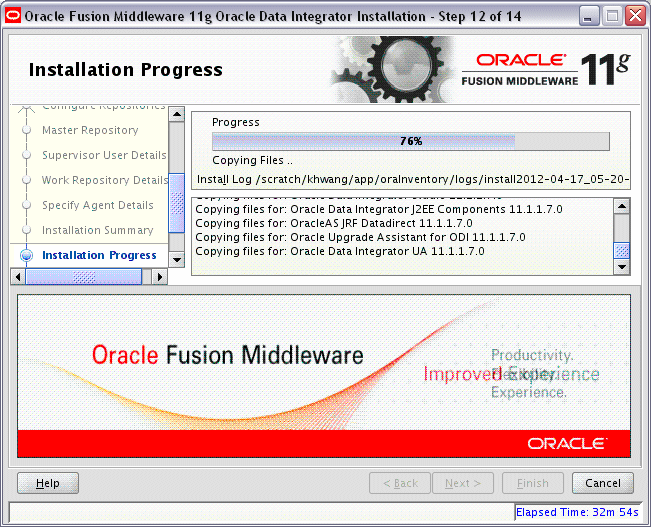
This screen shows you the progress of the installation.
If you want to quit before the installation is completed, click Cancel. Doing so will result in a partial installation; the portion of the software that was installed on your system before you click Cancel will remain on your system, and you will have to remove it manually.
A.2.14 Configuration Progress

If you selected Configure Repositories on the Repository Configuration screen, this screen shows you the progress of the component configuration. This screen will not appear if you selected Skip Repository Configuration.
If there is a problem, a short error message appears in the bottom portion of the screen. Fix the error and click Retry to try again.
If you want to ignore the error and warning messages and continue with the installation, click Continue.
Click Abort to stop prerequisite checking for all components.
If you want to quit before the installation is completed, click Cancel.
A.2.15 Installation Completed
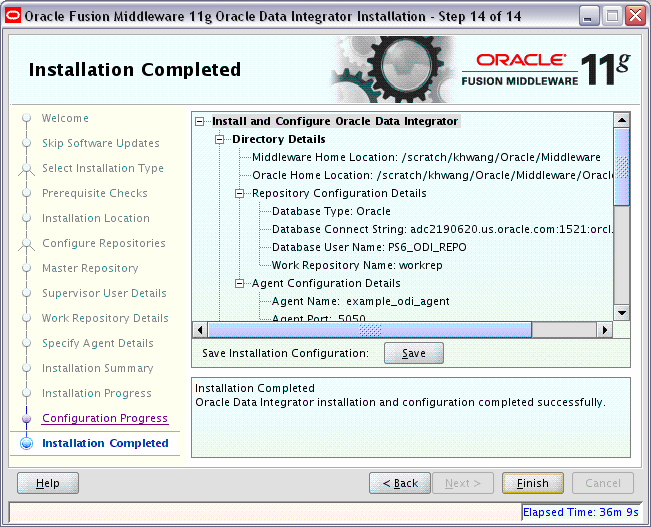
This screen summarizes the installation that was just completed. The information that you provided appears in the Directory Details section.
Click Save to save your configuration information to a file. This information includes port numbers, installation directories, disk space usage, URLs, and component names which you may need at a later time.
Click Finish to dismiss the screen.